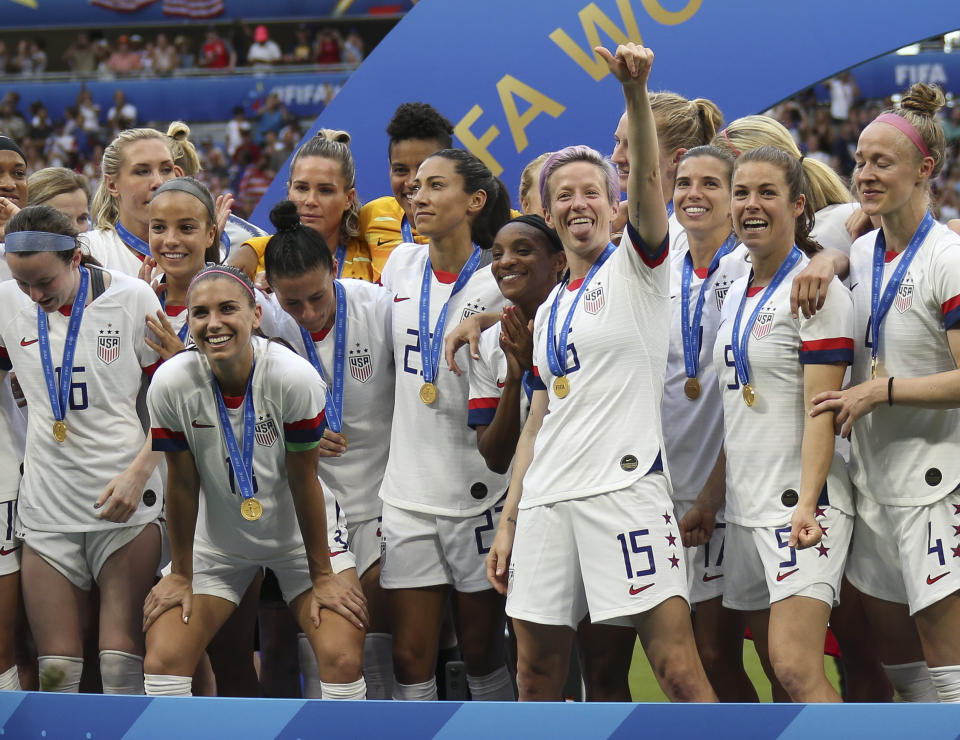For USWNT to stay atop women's soccer, here's what must happen
The National Women’s Soccer League needs help.
Or, to be more precise, it needs investment. The United States women’s national soccer team’s future success depends on it. And while that may sound strange after back-to-back Women’s World Cup titles, and three finals in a row, it’s absolutely crucial nonetheless.
Because the season after next, Real Madrid will finally field a women’s team in Spain’s top division. It will acquire an existing team and rename it – it was too late to put it all together for this coming season. And then it will budget about two million euros to make it competitive. Because that, it has worked out, is what it costs to compete in European women’s club soccer now.
Two million euros.
That’s almost $2.3 million. For a single team. And knowing Real and its irrepressible ambitions, that number is bound to creep up.
This season, the salary cap for the National Women’s Soccer League teams stateside is $421,500, with a maximum of $46,200 per player and a minimum of $16,538. Lots of players scrape by and are professional in name only.
This salary cap, it should be noted, does not include the salaries of the 20 or so players rostered full-time with the senior national team, who don’t count toward their team’s caps. That means the nine teams combine to spend about $3.8 million on player salaries without the national teamers – assuming they max out their salary caps. Generously, their payrolls include another $3 million or thereabouts when you include the national team, even though that money is paid by U.S. Soccer — which floats a lot of the league’s budget, in fact.
That’s still under $7 million for the entire league, which kicked off in 2013, primarily to give the national teamers somewhere competitive to play year-round and to develop young talent after college.
In France, Paris Saint-Germain alone spent some $7.4 million on its women’s team last year. Olympique Lyonnais, the gold standard in the women’s game, spent about $8.5 million on its star-studded squad. Even relatively humble Montpellier dropped as much as $4 million on its women’s team.

Last season, Manchester United’s women’s team alone had a budget of some 5 million pounds, or $6.3 million, and that was just to get it promoted into the Women’s Super League from the second-tier Women’s Championship in its inaugural season. More will be spent.
We don’t know how much Manchester City’s women’s team spends on players, but it’s no doubt significant, given that the team posted about $1 million in losses that were happily absorbed by the club’s Abu Dhabi ownership.
A year and a half ago, the average salary in England’s WSL was about $34,000, only just below the NWSL’s maximum salary at the time.
Atletico Madrid is one of women’s soccer’s other big spenders, although it’s unclear what its budget is. But at FC Barcelona Femeni, Dutch star Lieke Martens reportedly earns some $115,000 per year. Juventus Women has an operating budget of some $900,000, and other Italian clubs are following suit with fully professionalized women’s teams.
You get the idea.
It’s time to double down on the American women’s league, to find money to invest in it, somehow, somewhere, and make the salaries competitive with the rising powers in Europe. Because you can’t compel people to watch out of a sense of duty, or guilt them into it. It didn’t work after the 2015 World Cup and it won’t work now.
There have been encouraging signs during this World Cup – Budweiser signed on as a sponsor and ESPN committed to airing games on its cable channels; Yahoo Sports was already streaming them. But so long as single European clubs are outspending the entire NWSL, the irrelevance of the latter is an inevitability. The best players will leave North America, and that might well include the national teamers sometime down the line. At some point, staying here won’t make sense for them, financially or competitively. And rather than serve as an incubator for national team talent, and a logistically convenient stage for the current senior national team to stay sharp and in close proximity, the NWSL will do little to bring through new American talent as the level drops and the stars are scattered to the wind.
The effect of the investment in Europe on its national teams is already plainly obvious as they took seven of eight quarterfinal places on the back of more domestic investment. “The biggest example is Italy,” Dutch striker Vivianne Miedema told the Associated Press recently. “They put a lot of money into Juventus and in a couple of other clubs. You see it directly on the World Cup.”
Title IX and the cash it poured into women’s college soccer long gave the U.S. national team an almost bottomless well of elite talent. But professional academies are popping up overseas. And eventually, those will start churning out pro-ready players at a faster rate than the college game. For no other reason than the incentives will be stronger, the resources better and the pockets deeper.
The head start the Americans enjoyed for decades has eroded. The Europeans are coming. The South Americans will follow at some point. The only way to keep up is to have a domestic league that makes soccer a true profession for all its players.
Leander Schaerlaeckens is a Yahoo Sports soccer columnist and a sports communication lecturer at Marist College. Follow him on Twitter @LeanderAlphabet.
More from Yahoo Sports:


